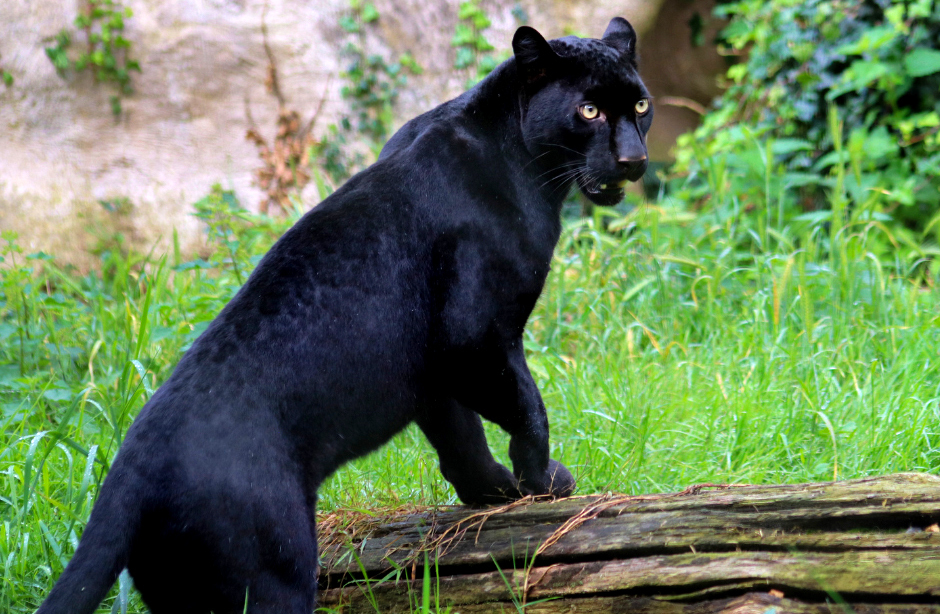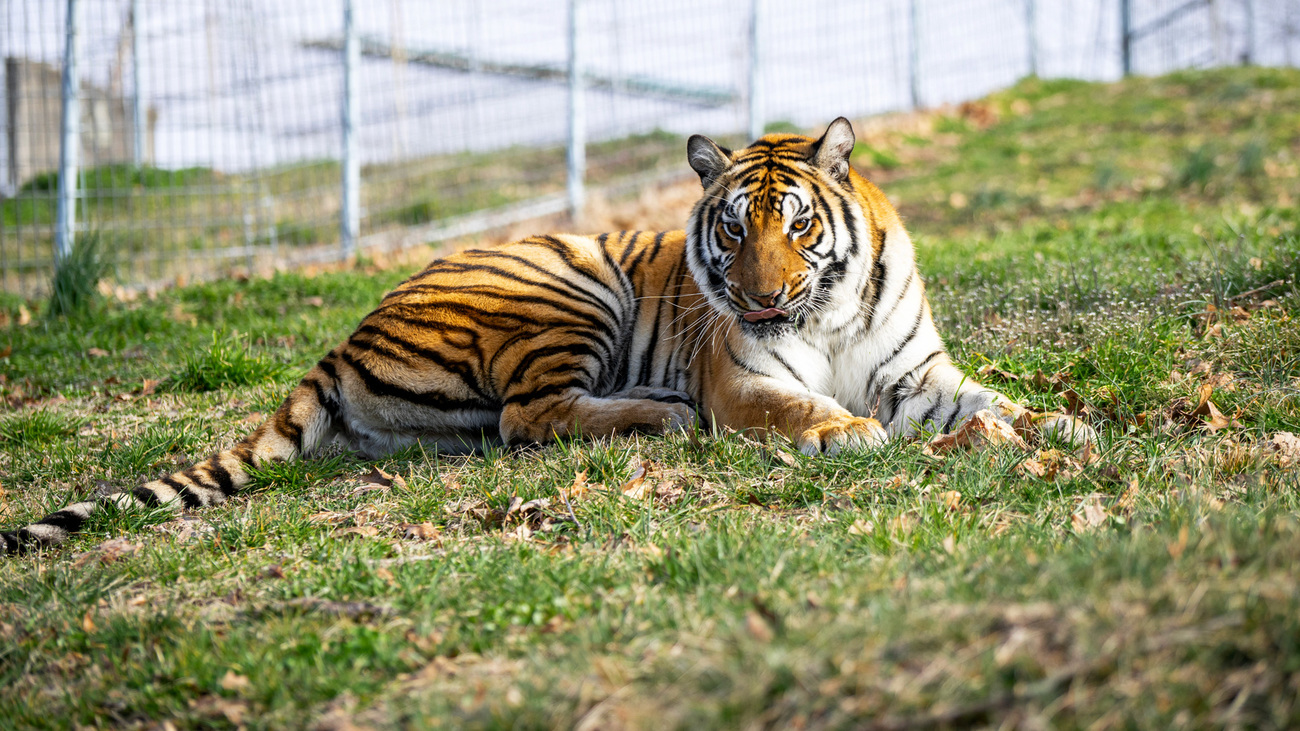Big Cats in Captivity: Rescue and Advocacy - United States
There are more tigers in captivity in the United States than there are in the wildHow to tell a real big cat sanctuary from a pseudo-sanctuary
How to tell a real big cat sanctuary from a pseudo-sanctuary
Captive big cat displays are a huge tourist attraction in many countries. Media like Tiger King have piqued public interest and curiosity in big cat exhibits, as people watched humans interact with big cats up close and personally.

However, Tiger King also showcased the dangerous consequences of these interactions for both animals and people. The show sparked necessary conversations about the exploitation of big cats, showcasing the prevalence of deceitful businesses that misrepresent themselves as animal ‘sanctuaries’ when they simply are not.
Captive big cats held in pseudo-sanctuaries often live in extremely poor conditions, exploited to make huge amounts of money for those who exhibit them. IFAW works to rescue big cats from these inhumane conditions, helping to rehome them to true sanctuaries that can meet these animals’ complex needs.
Visiting and otherwise supporting qualified big cat sanctuaries—like those that are members of the Big Cat Sanctuary Alliance—can be an excellent way to stand up for animal welfare, both by spreading awareness and donating to their operations.
So, how can you tell the difference between a true big cat sanctuary and one that’s simply posing as a sanctuary—in other words, a pseudo-sanctuary—to attract paying visitors? In this blog, we help you distinguish between legitimate sanctuaries and exploitative operations, ensuring that you can effectively support the care of big cats.
The dangers of pseudo-sanctuaries
Businesses pretending to be animal sanctuaries often have extremely poor animal welfare standards. Though the people who visit these businesses are deceived into thinking that the big cats are well cared for, it is often far from the truth. Going to a pseudo-sanctuary also puts your health and safety at risk. Plus, it harms real conservation efforts.
Dangers to public health and safety
Wild cats are not supposed to interact with humans. In real animal sanctuaries, only experts and veterinarians handle the animals, and only for medical purposes with proper sedation.
Contact is limited to the bare minimum, only occurring when absolutely necessary to improve their health and well-being.
It is extremely dangerous for people to handle wild cats of any age, as such contact creates a significant risk of injury and zoonotic disease spread.
Harm to conservation efforts
Real wildlife sanctuaries, such as those in the Big Cat Sanctuary Alliance, aim to promote the highest welfare standards for rescued felines, which may include endangered species. They educate the public on why protecting these species is important and what they can do to help.
Conversely, businesses that exploit big cats do little to nothing to educate the public on conservation. In fact, seeing these big cats being rapidly bred in captive settings can lead to the false perception that these species are not at risk of extinction in the wild and don’t need protection.
As a conservation organisation, IFAW works to combat wildlife trafficking and the exploitation of endangered species every day. In addition to contributing to animal mistreatment, pseudo-sanctuary displays can contribute to wildlife trafficking and unsustainable trade.

The benefits of legitimate big cat sanctuaries
Legitimate wildlife sanctuaries—like members of the Big Cat Sanctuary Alliance and those accredited by the Global Federation of Animal Sanctuaries—have a positive impact on the welfare of rescued animals.
Work by animal sanctuaries and conservation organisations like IFAW led to the passage of the Big Cat Public Safety Act, which helps to safeguard big cats across the US. Not only does it prohibit the private ownership of tigers, lions, leopards, and other big cats, but it also restricts dangerous interactions between these wild animals and members of the public. The first big case under the BCPSA was to save protected wildlife—a jaguar cub—from being sold and harmed.
True animal sanctuaries, like members of the Big Cat Sanctuary Alliance, uphold the highest standards of animal welfare for big cats and other rescued wildlife. They encourage the natural behaviours of these wild animals, prohibit human-wildlife contact, ensure that they receive adequate nutrition, and provide lifelong, expert animal care.
Not all big cat sanctuaries are open to the public, but where they are, they allow visitors to view the big cats from a safe distance, protecting the health of both the big cats and the humans. Visiting true big cat sanctuaries plays a role in responsible tourism, which is critical to protecting wild animals in captivity.
How to identify legitimate big cat sanctuaries in the US
Here are the key features that distinguish a legitimate sanctuary from an exploitative big cat business.
No public contact with wildlife
Captive wildlife at true sanctuaries should have no contact with humans outside of specific medical care circumstances. In the exceedingly rare circumstances when contact is necessary in rescue or rehabilitation, a highly trained and qualified professional should take charge and keep contact to a minimum.
Allowing interactions with captive wildlife up close—which, in the case of big cats, is prohibited under the Big Cat Public Safety Act—is highly unethical and distressing to the animals. Ensure that the sanctuary you’re visiting does not promote any direct public contact with any captive wildlife. If the facility is a legitimate sanctuary, they won’t allow the public to handle animals.
Animals are not bred, bought, or sold
Organisations that buy, sell, or trade captive felines usually do so for profit—and animal welfare is often their last consideration.
True sanctuaries do not breed animals. If a facility promotes the breeding of captive big cats or other wildlife, even for so-called ‘conservation purposes’, it is NOT a true sanctuary.
Proper space and enrichment
Real sanctuaries provide big cats with space to roam and enrichment activities to stimulate their natural behaviours. If a facility regularly keeps its big cats caged up in small or otherwise unsuitable spaces, it’s unlikely that it's a legitimate sanctuary.

Compliance with laws and regulations
A legitimate big cat sanctuary complies with laws like the Big Cat Public Safety Act. This law prohibits the private ownership of big cats, restricts contact between the public and these animals, and protects big cats from exploitation. If an organisation posing as a sanctuary promotes close contact with the animals, cub petting, or photos, it violates this law.
Many countries also have regulations around animal welfare. The Animal Welfare Act in the US stipulates minimum standards of care and treatment. However, a legitimate sanctuary should be doing more than the minimum for animal welfare, ensuring that the big cats in their care have a good quality of life that gets as close as possible to how they’d live in the wild.
Transparency and accountability
A true sanctuary is completely transparent about the care it provides for its big cats. They won’t use vague, too-good-to-be-true messaging. Instead, they share an educational message with the public. They discuss the harmful effects of wildlife trade and exploitative practices, and are working toward a world in which sanctuaries are needed less and less.
Remember, even if owners of a facility call themselves ‘conservationists,’ that doesn’t mean it’s true. Breeding big cats like tigers in the US does nothing to solve the on-the-ground threats that jeopardise these animals in the wild. It’s important to do your research before visiting.
Part of a recognised network (like BCSA)
Legitimate sanctuaries are accredited by respected organisations like the Global Federation of Animal Sanctuaries (GFAS) or American Sanctuary Association (ASA). For felines, Big Cat Sanctuary Alliance membership is also an excellent signal that a sanctuary is qualified and has been thoroughly vetted. Accreditation by these expert entities indicates that the facility meets certain animal care and management standards and is periodically assessed and verified.
How the Big Cat Sanctuary Alliance provides quality lifetime care for wild animals in captivity
Wild cats living in captivity deserve to live safe, healthy lives—and that’s why IFAW founded the Big Cat Sanctuary Alliance. Not only do its members ensure that the wild cats in their sanctuaries receive a lifetime of quality care, but they’re also fighting against the private ownership and commercial exploitation of big cats and other wild felines.
As an alliance, these legitimate sanctuaries have a bigger voice about the exploitative practices carried out by pseudo-sanctuaries. They also educate the public about the challenges big cats face in the wild and in captivity. Most importantly, they provide rescued big cats with quality, lifetime care free from exploitation.
The Big Cat Sanctuary Alliance stands against:
- Public contact with wild cats
- Breeding of hybrid wild cats, especially to achieve rare colour morphs
- Defanging and declawing of wild cats (unless for medical purposes in the best interest of the individual animal)
- Depiction of wild cats in the media as domesticated animals that are safe to interact with
- Recreational killing of wild cats
- Keeping and exhibition of wild cats in zoos without the correct accreditations
- Private ownership of all wild cat species and hybrids
- Commercial breeding of wild cats
- Use of wild cats for cub petting, photographic opportunities, or other public interactions
- Use of wild cats for any type of entertainment
- Breeding, selling, and possession of wild or domesticated hybrid cats

Help support big cat sanctuaries
Do your research to ensure that you’re supporting legitimate big cat sanctuaries. Membership in the Big Cat Sanctuary Alliance (BCSA) and accreditation by the Global Federation of Animal Sanctuaries (GFAS) both indicate that a sanctuary operates in accordance with the highest animal welfare standards.
You can support these legitimate sanctuaries by donating, volunteering, or through responsible tourist visits.
Support big cat sanctuaries >>
Related content
Our work can’t get done without you. Please give what you can to help animals thrive.